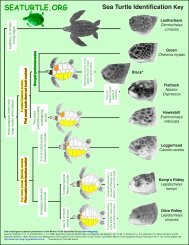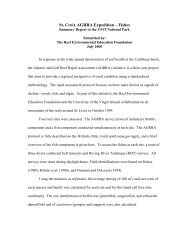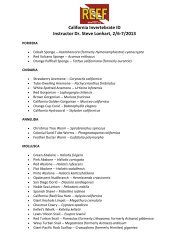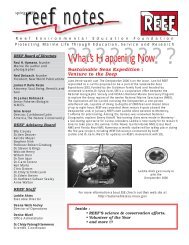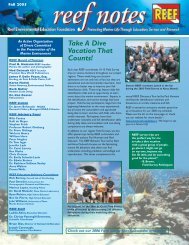Exotic Species Brochure - Reef
Exotic Species Brochure - Reef
Exotic Species Brochure - Reef
You also want an ePaper? Increase the reach of your titles
YUMPU automatically turns print PDFs into web optimized ePapers that Google loves.
WANTEDEXOTIC SPECIESINTRODUCED = INVASIVE = NON-NATIVE = ALIEN = NON-INDIGENOUS = EXOTICWHAT IS AN EXOTIC SPECIES?These are all terms used to describeorganisms living in areas beyond theirnatural range whose introduction was causeddirectly or indirectly by humans. It is illegalto release non-native species into statewaters. Despite this, exotic species are onthe rise throughout the state. This includesseveral species of non-native reef fishes, suchas those pictured here. While they may lookpretty, these fish are not welcome additions toour reefs.WHY ARE EXOTIC SPECIES HARMFUL?<strong>Exotic</strong> species are widely regarded as one of the top threats to the maintenance ofecosystem health. They thrive in their "new" home because of a lack of predators andan abundance of prey that are ill-suited to defend themselves against the invader.When an exotic species thrives, it often competes with native species for resources suchas food and shelter. This competition can result in the decline of native populations.<strong>Exotic</strong>s can also introduce new parasites and diseases to the ecosystem. The U. S.Geological Survey places exotic species as the third most responsible factor fordramatic declines in biodiversity. It isimportant for these species to be detectedearly because once established, they aredifficult to remove without further damagingthe ecosystem. The cost of removing an exoticspecies can be quite high; it is estimated thatit costs the U. S. economy $1 billion a year toremove and mitigate the effects of exoticspecies on aquatic ecosystems (College ofAgriculture and Life Sciences, CornellThe red lion fish native to the Indo Pacific, has beensighted from New York to Florida.University).Emperor angelfish, native to the Indo Pacific has beensighted off Pompano Beach, FL.EXOTIC APPREHENDEDOn April 27, 2000, two orbicularbatfish (Platax orbicularis) werecollectedfromMolasses<strong>Reef</strong> off thecoast ofKey Largo,Florida.NormallyOrbicular batfishfound inthe Pacific Ocean, these fish were mostlikely released into the wild by homeaquarium owners after they grew toolarge for their tanks. The batfish areoften seen with the native AtlanticSpadefish. In removing these intruders,REEF, the Florida Keys National MarineSanctuary, Dynasty Marine, Inc., andthe New England Aquarium launched acooperative effort to preserve reef healthin the Florida Keys. The batfish are nowon exhibit in the New EnglandAquarium as "poster fish" for thedangers of exotic species in coral reefenvironments.SPREAD THE WORDKEEP OUR MARINEECOSYSTEMSHEALTHY.VISIT www.reef.org/exotic TO REPORT AN EXOTIC SPECIES SIGHTING






